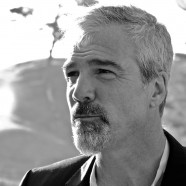
Today, LACMA and roughly 70 other art institutions across Southern California are brimming with works by Latino artists as part of the groundbreaking Getty-led initiative, “PST: LA/LA.” Ironically it includes numerous works by Asco members.
“The thing with Asco, we came out of a generation that had a political notion of the way the world was. It’s taken different shapes and different forms, but there’s a presence there,” Gronk tells PR for People about the group, whose name is Spanish for “nausea” or “disgust.” One target of that disgust was the disproportionate number of Chicanos coming back from Vietnam in body bags.
East L.A.’s Garfield High, a school that experienced walkouts in 1968 over unequal conditions, is one institution Asco members have in common, but a sturdier bond was forged working on Regeneracion, a Chicano art culture and literary journal edited by Gamboa with the others on staff. It became a hothouse for ideas such as “Stations of the Cross,” their 1971 Christmas Eve Posada for which they painted their faces and bore a 15-foot cross through the neighborhood to a local army recruiter, where they left it in protest of the war.
“First Supper (After a Major Riot)” had the group in death masks and top hats seated at a dinner table set with food on a traffic island on Whittier Boulevard, the site of a police shooting during a riot with anti-war protesters. “For us, experiment was a part of our growing up and trying to do things. But also being young, physically, we were using our bodies in many ways to create things,” Gronk explains, with Valdez adding, “The other thing was our budget, which was zero. So we used things that were readily accessible. What was interesting about being limited with your resources is it makes you more inventive.”
Arte Povera was an obvious Asco influence, but so was a layered combination of identity and Dadaist elements creating ephemeral artworks that defied definition. “I always considered myself the Roger Corman of the art arena,” says Gronk, referring to the king of B-movies. “So everything comes in under budget with desperation.”
One of their signature works was No Movies, a series of staged photos that appear to be part of a movie that doesn’t really exist. “Historically most people gravitate toward Cindy Sherman being the actress of her photography,” notes Gronk about Sherman’s series Untitled Film Stills, which started her career several years after No Movies. “Early on that was kind of our notion, since we weren’t really represented in Hollywood. And since they wouldn’t let us in, let’s just invent our own cinema.”
Valdez’s movie, Hot Pink, currently showing at Los Angeles’ Hammer Museum as part of their show, Radical Women: Latin American Art, 1960-1985, is her own reaction to Hollywood exclusion. “I didn’t have to wait to be discovered. I’ll be a film star on my own,” she says of the movie that featured her friends, heavily made up, kissing, touching, hugging, casually detached under saturated pink tones. It provides a rare glimpse of a specific segment of youth culture at the time.
It wasn’t until the 1980s that Valdez began to apply herself to painting. The first person she showed her work to was Gronk who simply responded, “More paint.” “He could do masterpieces in three minutes and I’d be in the corner crying,” she recalls.
She’s not crying anymore, since she recently realized a lifelong ambition to be part of the permanent collection of a major museum. “I’m part of the collection at the Hammer, two images of me, my work that’s in the show,” she smiles. “Now I’m just waiting for my own show in a major museum, which hasn’t happened yet.”
Gronk had his first L.A. solo show in 1994 at LACMA, reconciling with an old nemesis. “It’s defacing the inside as well as the outside,” is how he recalls it. “That, to me, was an important statement.”
For the past 20 years he’s been working with theater director Peter Sellars on operas like Ainadamar, Griselda and The Indian Queen. “There’s always an undercurrent of politics in the pieces he does,” he says of Sellars, with whom he plans to collaborate on a site-specific production to take place in Dunhuang, China. “I know there’s going to be something of value that I’m going to learn from the experience. But also an audience will get a bit of something that, as old as opera is, is a new thing that’s added to the mix.”
He still starts the day with his morning coffee draw, a doodle that gets his creative juices flowing. “Most of the time people think of the arts as being fluff. The one thing they don’t see, it’s a discipline,” he explains. “You do it constantly in order to be able to do it well.”
Jordan Riefe is an LA-based journalist who writes about arts & culture.
Photo Credit: Asco ©1974, Harry Gamboa Jr.









